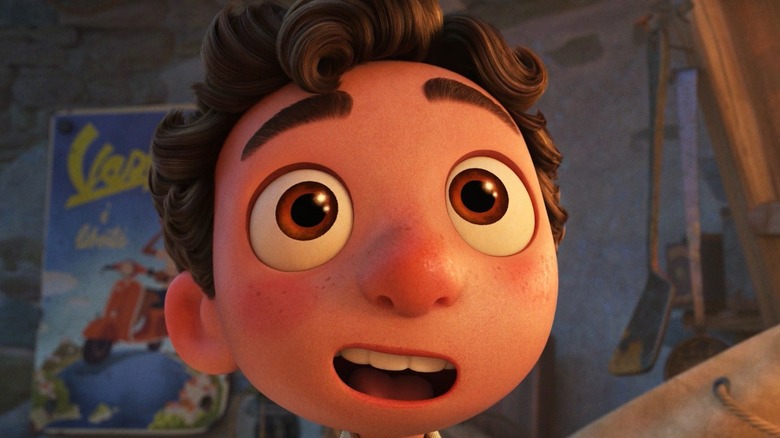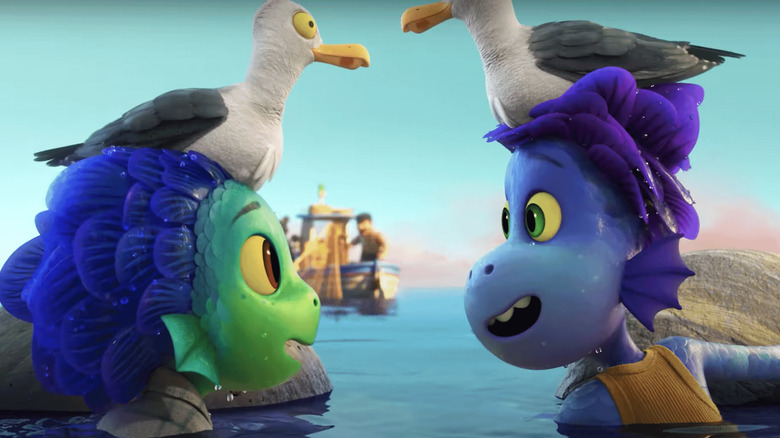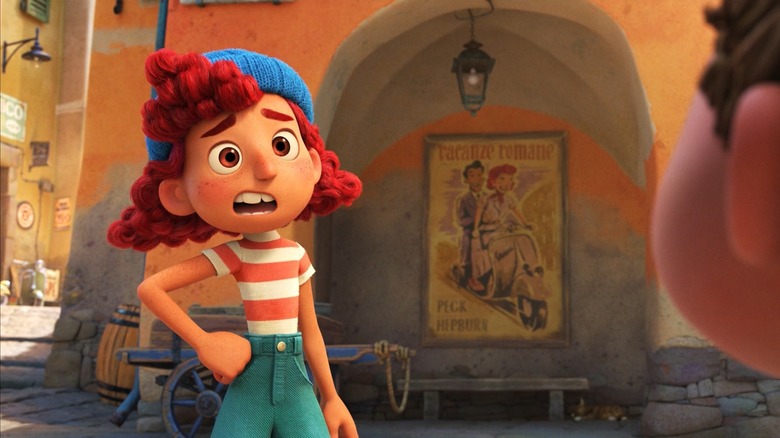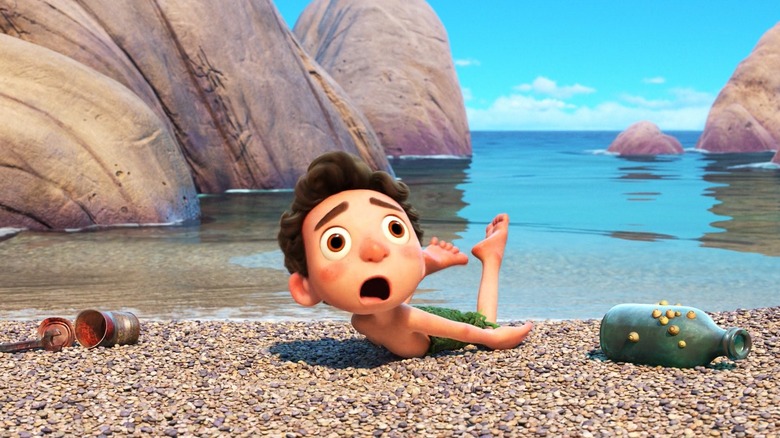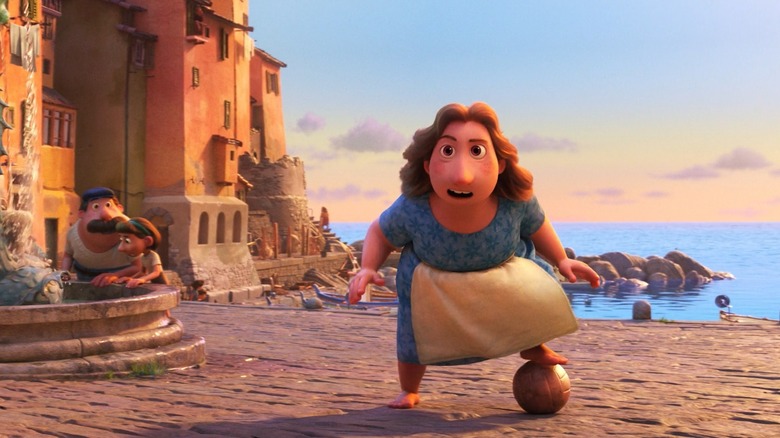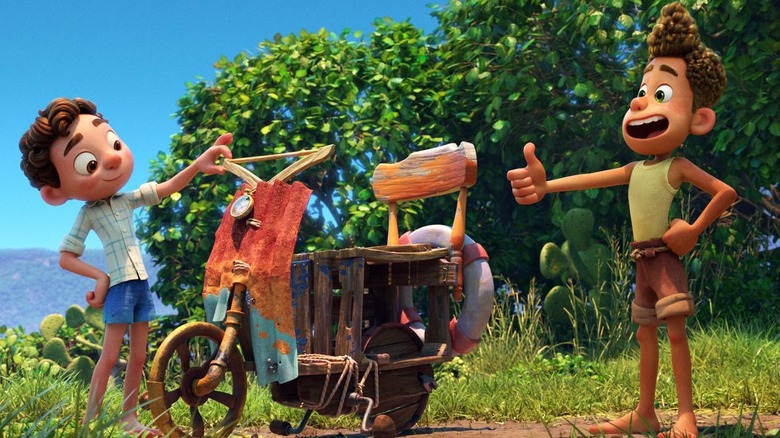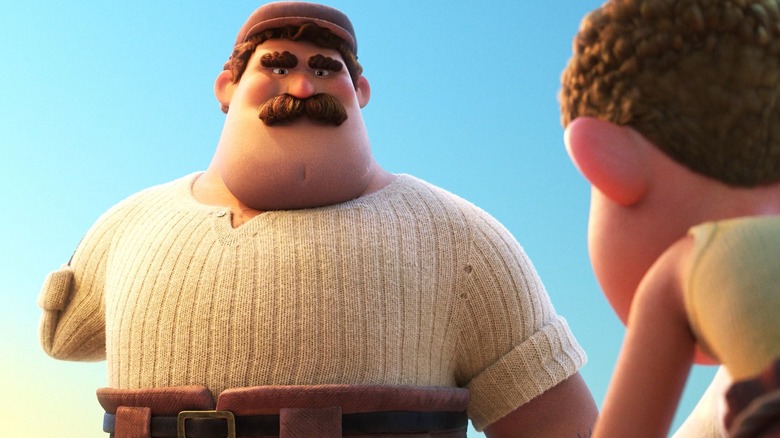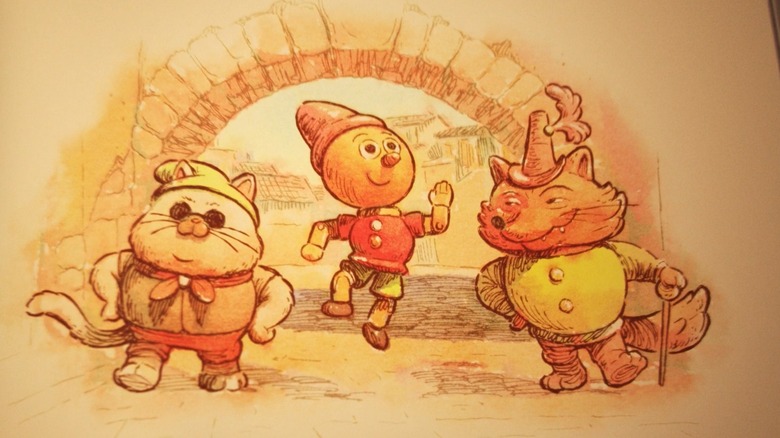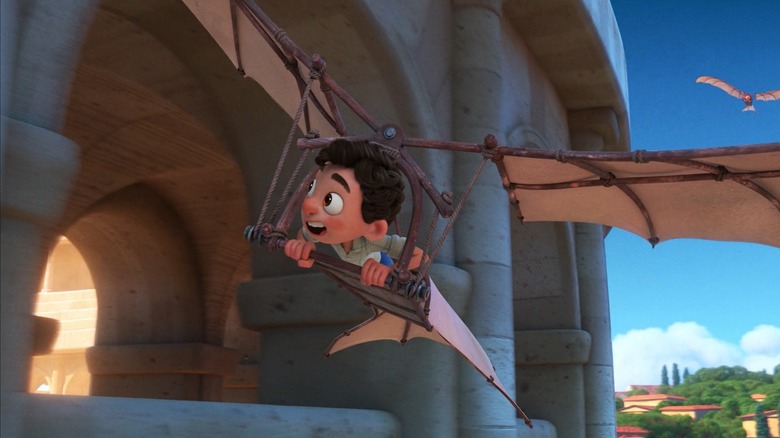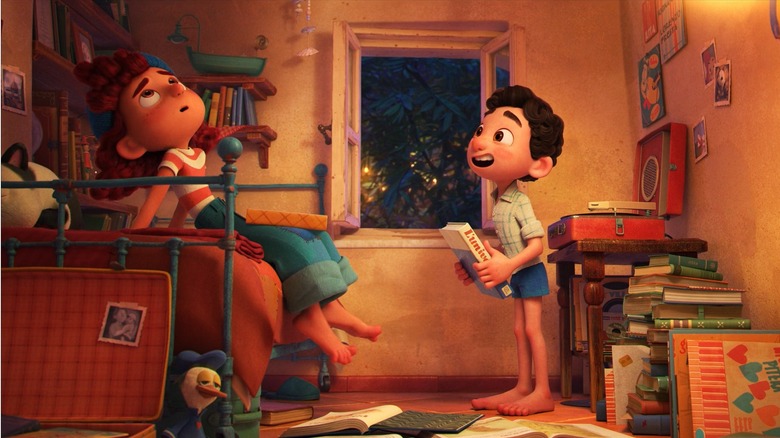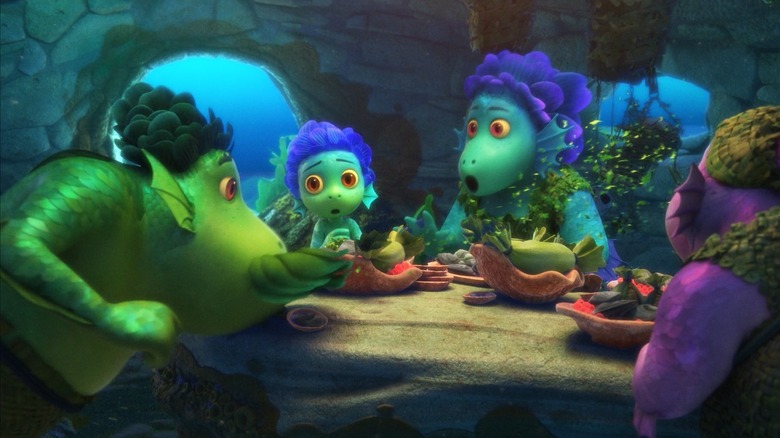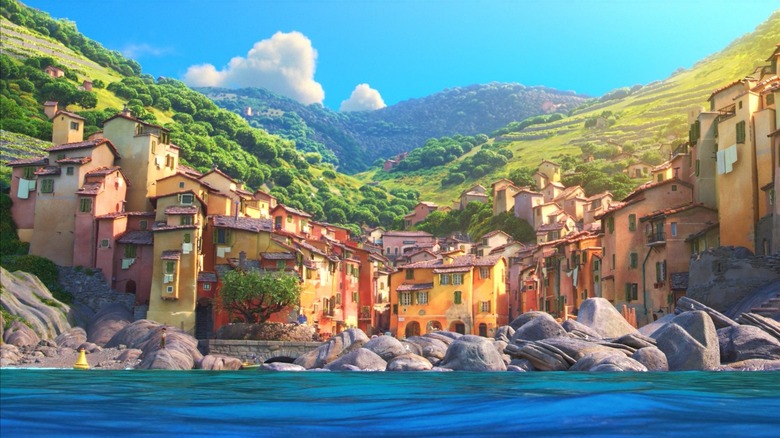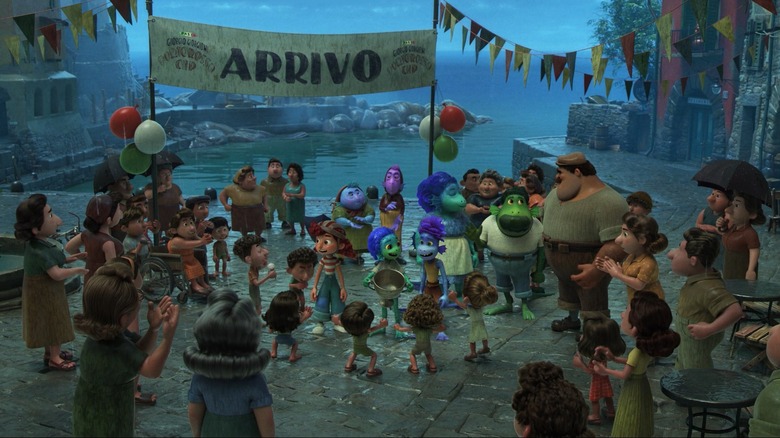Things Only Adults Notice In Luca
Pixar's third feature film about aquatic life stars Luca, a young sea monster who lives with his parents and wonders about what lies above the water's surface in the very human realm of "the land monsters." Once there, he finds friendship in Alberto, a sea monster who has made a life for himself on the land. Naturally appearing as humans when dry, Alberto and Luca journey to the nearby town of Portorosso, where they dream of getting a Vespa so they can travel the world together.
Directed by Enrico Casarosa, "Luca" is Pixar's first film created by someone not born in the United States, as Casarosa was born in Genoa, Italy. Though he had previously directed "La Luna," a Pixar short which was shown before the movie "Brave" in 2012, "Luca" is Casarosa's feature debut.
While many viewers may see something familiar in the depictions of growing up and making friends, there are some aspects of "Luca" likely to pass younger viewers unnoticed. Here are things only adults notice in "Luca."
Luca is a literal fish out of water
There are many films, television shows, books, and stories that center on a character entering a foreign land with customs, languages, and social norms that are entirely new to them. Because this allows any audience to quickly acclimate to a new environment through the main character learning about their new surroundings, the fish out of water narrative structure is incredibly common.
In fact, this trope is so common that "Luca" isn't precisely the first Pixar film to fall into this narrative category. Entries in the Pixar canon such as "Cars," "Ratatouille," "WALL-E," "Monsters University," and "Coco" all share a similar style of thrusting their characters into strange worlds where they feel like outsiders. But common framing technique or not, no Pixar film has ever gone so far in taking its storytelling idiom so literally. With Luca literally bursting from the sea and needing to be taught how to walk on dry land, Pixar has perhaps achieved the ultimate fish out of water narrative, both figuratively and literally.
Italian film references abound
To say "Luca" is a personal film is a bit of an understatement. Being the first Italian to direct a Pixar film, it's no wonder "Luca" strongly evokes the culture and aesthetic of Italy. In talking to Slashfilm, the film's director Enrico Casarosa spoke about how much of the project is based on his memories. He said that his goal was to "take everybody to Italy and [have] these wonderful memories, [let's] make this a true love letter to the place."
So naturally, as an Italian filmmaker, it makes sense that "Luca" is stuffed to the gills with references to classic Italian cinema. Some of the references are small, such as a street sign in the background where Alberto and Luca first ask Giulia about the race. Viewers may notice that the sign reads "Vicolo De Sica," which translates to De Sica Alley. Vittorio De Sica is the director of some of the most celebrated Italian Neorealist films like "Shoeshine," "Umberto D.," and "Bicycle Thieves." More blatant references are seen as film posters in the town square. One of the films playing in the local cinema appears to be the 1954 Neorealist classic "La Strada," directed by Federico Fellini, arguably the most famous Italian director of all time. Though Italian filmmakers didn't make the title, one of the other films advertised in the square is made by an American director and stars non-Italian actors: "Roman Holiday," which, to be fair, was filmed entirely in Rome.
Phantom tail is a real thing, or at least it would be
When Luca gets out of the water and goes through his human transformation for the first time, he immediately notices that his new body lacks a tail. Yet strangely, he expresses a feeling that his tail hadn't gone away. Upon telling this to Alberto, he replies, "Yeah, that's called phantom tail. You'll get used to it." Though morphing from a sea monster into a human is a fictional aspect of this tale, the concept of a phantom tail isn't exactly outside the realm of reality.
According to the Cleveland Clinic, this is a regular part of missing a limb for many people. In fact, "An estimated 8 out of 10 people who lose a limb experience some degree of phantom pain." However, not everyone feels a lost limb in a painful way. These types of feelings are referred to as phantom sensations. Since Luca and all of the people who live underwater gently change into a human form upon becoming dry, it makes sense that there isn't any apparent pain involved with losing one's tail. So while the condition "phantom tail" may not exist seeing as humans don't have any tails, the sensation it is based on is a genuine medical phenomenon.
Luca's parents terrorize the humans
When Luca's parents, Daniela and Lorenzo, arrive on dry land to find their son, they quickly realize that walking around in woven kelp might be a bit conspicuous. So they find a set of clothes that had been set out to dry on a clothesline overnight and help themselves. Since Luca's parents only had kelp clothes and no money to speak of, the two understandably stay in the same set of clothes during their entire search for Luca. Putting aside the fact that someone from the town could have recognized their missing laundry when Luca's parents embrace him upon winning the Portorosso Cup, it's odd that Daniela and Lorenzo don't seem to have a problem staying in stolen clothes the rest of the time they are above sea level.
In addition, while they search for Luca, Daniela decides to throw kids into a fountain to see if any get scaly. Knowing at least that plucking the kids and dunking them one by one would be improper, she challenges a crowd of kids to take a soccer ball from her. What follows is a sports action scene that ends with each kid getting hip-checked or the ball hitting their sternums and kids face-planting in the water left and right. While it's sweet Luca's family would go to such lengths to bring their child home safely, they certainly have no qualms terrorizing the humans in their quest to find Luca.
Alberto has abandonment issues
One of the film's more introspective characters is Luca's friend Alberto. When the young sea monster is introduced, Alberto explains to Luca that his dad frequently leaves him alone to do what he wants on the surface world. Compared to Luca's overprotective parents, this is initially seen by Luca as a dream scenario. After all, Alberto can travel freely between the land and the ocean and do whatever he pleases.
As Luca becomes closer to the human girl Giulia, it becomes apparent that Luca's dreams may not align entirely with those of Alberto. While the pair of young dreamers had hoped to win a Vespa to travel the world together, Luca finds himself dreaming more and more about Giulia's human school. Of course, to Alberto this shift is difficult for him to accept, and ultimately a heated fight breaks out between the two, culminating in Alberto's aquatic form being revealed. Instead of sticking by his friend, Luca betrays Alberto in the heat of the moment.
When Luca goes to apologize, it is revealed that Alberto had long ago been left behind by his father. Luca is the only meaningful connection Alberto has. So when Luca considers giving up on their shared dream to go away with Giulia, Alberto sees Luca as abandoning him, just as his own father had done. In a final act of growth, Alberto gives up his Vespa to let Luca go to school, finally attaining a new sense of family with Giulia's dad, Massimo.
The film is real casual about the diversity of its characters
In Pixar's 2003 film "Finding Nemo," a lot of the interpersonal conflict between Marlin and Nemo revolve around Marlin being overprotective due to Nemo's "lucky fin." In short, a lot of the film was about Nemo proving both to himself and to his dad that despite being physically different, he could handle himself just fine.
"Luca" decides to handle its representation of Massimo, who was born with one arm, in a way that centers less on his differences. There are shots of his empty sleeve, fastened shut with a fishing hook that the boys glance nervously at (seemingly out of fear of all the sharp fish-killing implements in his house). Later, when Massimo notices that Alberto is staring at his sleeve, he answers the question that Alberto is obviously wondering about, saying that a sea monster ate his arm. He then laughs at the cliche and tells the boys, "This is how I came into the world." Beyond that interaction, the film is very low-key about the inclusion of a character with a disability.
Luca's trying to be a real boy, just like Pinocchio
One of the subjects that Giulia teaches Luca about is the story of Pinocchio, as it was originally written by Carlo Collodi. Giulia's book isn't the only bit of "Pinocchio" in the film. In addition to the book, Giulia also has a figurine of the wooden puppet on a shelf above her bed. But the references to the wooden puppet who wanted to be a real boy extend to the film's soundtrack, where the song "Il gatto e la volpe," or "The cat and the fox," details interactions between Pinocchio, a cat, and a fox, according to ScuolaScuola.
In a way, Pinocchio, Alberto, and Luca are all very similar in their desires to be real boys. For Alberto, he yearns to be important to Luca and first does this by claiming to be an expert on all things human. Luca first learns about the world and agrees to travel with Alberto because he wants to learn all of the interesting things that the human world holds. And though their noses don't grow with every lie they tell, the boys are revealed as inhuman whenever they are wet. However, in a departure from the original tale (which likely is not suitable for the target demographic given the dark themes), Luca and Alberto find out that they don't need to be human; they just have to be themselves.
Luca learns about real Italian contributions to science and culture
When Giulia starts teaching a fascinated Luca about the world and what exists beyond it, she seems to go about doing so in a way that mimics many of the fields that saw significant advancement during the Italian Renaissance. One of the most poignant examples is Giulia showing Luca that he is wrong about the stars being, what Alberto refers to as, sardines. In addition to looking through a telescope like famed Italian astronomer Galileo, Luca is shown some of the books that Giulia keeps in her room, each one open to famous Italian contributions to culture.
In addition to a diagram of the solar system, a sketch of the flying machines dreamt up by Leonardo de Vinci can be seen. Yet another book shows a picture of the ancient Roman Colosseum, one of Italy's most popular tourist attractions. Adding to the other Italian contributions to understanding the world and incredible feats of engineering is one more open book that is distinctly Italian. Though many Americans would likely think of "Pinocchio" as a Disney story, the original tale was written by Carlo Collodi, an Italian novelist.
Disney and Pixar easter eggs
Disney and Pixar are known for their films being filled with references to the company via obscure easter eggs. Sometimes they are deemed somewhat controversial, but oftentimes viewers misconstrue innocent images into something more suggestive, resulting in the birth of untrue urban legends, like the letters S-F-X spelling S-E-X in "The Lion King." Sometimes, these are fun little easter eggs to notice like hidden Mickeys, references to one particular classroom at the California Institute of the Arts, and Luxo, the lamp that hops on top of the I in Pixar.
"Luca" follows the pattern of hiding references to other Pixar properties for viewers to find. Similar to the hidden Mickeys is another familiar face that can be seen plainly in Giulia's room as she shows Luca her books. Sitting on the floor at the foot of her bed is a small plush of Donald Duck. Another easter egg is hidden in the text on the train ticket that Alberto gives to Luca at the end of the film. Printed on the small paper is "Genova via Portorosso A113 Lire 600." In another classic Pixar nod, the Pixar ball can be seen on one of the rooftops of Portorosso during the climactic Portorosso Cup race.
Going to the surface is talked about like puberty
When Luca arrives home an entire two minutes late, his mother asks about his tardiness, asking if there was a boat that forced him to hide until it passed. As the conversation around the dinner table gets going, Luca is exceedingly interested in learning more about the surface world after seeing a few baubles that fell off a boat. Luca decides to broach the topic of the surface and asks where boats come from. His father immediately spits out the food in his mouth as his grandma casually informs him that she beat a guy in a game of cards in the nearby human monster town.
Given the reverence in Luca's voice when he asks his grandma if she's been through "the change," and the way that she replies to Luca's mom about him being old enough to hear about the surface, the flow of conversation likely sounds familiar to many adults. Countless similar discussions have been had between anxious parents who are loath to acknowledge their kids' unexpected maturity and curious, growing kids. Though instead of bodies changing once they're dry, many adults will remember talking about distinctly different ways that bodies change along with how birds and bees factor into things.
Miyazaki influences run deep
Though "Luca" is steeped in Italian culture, not all elements of the film are centered around Italy. Casarosa drew a lot of influence in his filmmaking from one of the creative icons of his childhood. When talking to Slashfilm, Casarosa admits to having been a fan of Miyazaki since childhood, saying, "I'm such a [fan] of Miyazaki. He's a hero, you know, and I've had a chance to meet him. He's looming large in my DNA."
The most obvious way Miyazaki influenced Casarosa can be seen in the name of the town in which the film takes place. The seaside village of Portorosso sounds quite a bit like the title of one of Miyazaki's films about an anthropomorphized animal living among humans: "Porco Rosso." While this apparent bit of homage is rather obvious, there is another aspect of Miyazaki that can be found in Luca, but on a deeper level.
Casarosa admitted to loving "that eye for detail and that eye for nature" present in Miyazaki's films. Akin to the nostalgic, lived-in atmosphere of "From Up on Poppy Hill," Casarosa is able to rely on childhood memories of summer hijinks to recreate Italy on screen. Much like Miyazaki working on an animated depiction of Casarosa's hometown in "3000 Leagues in Search of Mother," "hopefully, there was something I could give to that place, because I experienced those summers and was there for it."
The film's message is about the bravery of being yourself
Luca, Alberto, and Giulia go through a lot over the course of the film and end up growing from their experiences. Giulia finds herself a member of a team and not just standing on the outside of life in Portorosso looking in. Alberto can move past the insecurities that stemmed from his dad leaving him. However, one of the first significant instances of personal growth in the film is exhibited by Luca during the Portorosso Cup.
After Alberto is revealed to the entire town as a sea monster due to the falling rain, Luca decides to charge headfirst into the inclement weather to save his friend. In the end, Luca finds the courage to boldly stand in solidarity with his friend and be himself, even though it could mean forfeiting his hopes and dreams that might have been achieved through assimilation into human society. When his parents worry about him being in the human world, his grandmother says, "Some people, they'll never accept him. But some will. And he seems to know how to find the good ones." The film reinforces this message by having Luca's family support his decision to go out into the world, proudly showing his true colors.
